|
Page < 1 2 3 4 5 6 7 8 9 10 11 12 >
A Glorious Hindu Legacy: Indic influence in Southeast Asia.
Bali,
Indonesia -
Hindu Temple - Goa Gajah 
The
Balinese practice Hinduism with great pride. It
might not even be too way off the mark to say that in today’s
age, Bali is probably the only place where Hinduism is closest
to being practiced in its true form. Bali has been given many
other names like, The Island of Peace, Island of Gods, The
Morning of the World and so on. Perhaps to this list should be
added The Island where Hindu Sacred stories and Legends are
Reality.
Every part of Bali’s
panorama is infused with stories from Hindu epics
- The Ramayana and
The Mahabharat.
For example, almost
everywhere one goes in Bali one would see a statue of some
character from either of these two epics. The one that easily
come to mind is the depiction of the fight between
Rama
and Ravana at the roundabout just outside of Ngurah
Rai International Airport. The Goa Gajah,
also
known as the Elephant caves, which dates back to at
least the 11th century, was excavated in 1922. Not
far from the central Bali town of Ubud is Goa Gajah, popularly
known as the Elephant Cave. The cave is a former
hermitage for the eleventh century Hindu priests.
The Goa Gajah cave in Bali.
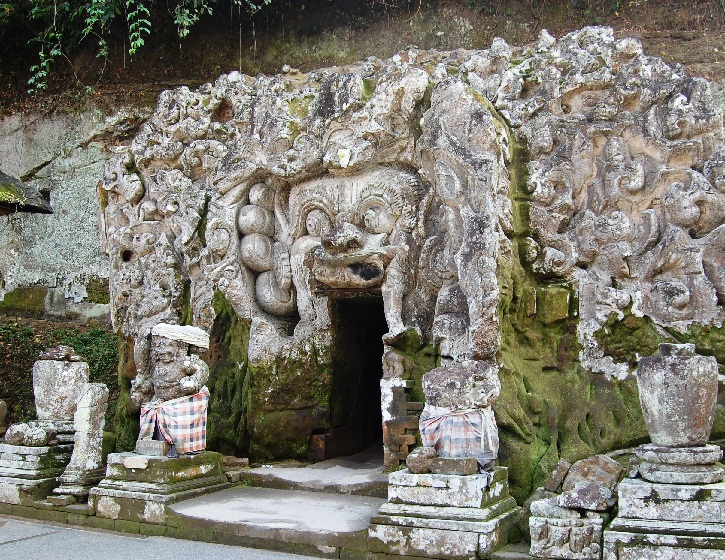
The Goa Gajah, which dates back to at least the 11th
century, was excavated in 1922. A huge face at the entrance of
the cave for ascetics. All around are fantastically carved
leaves, animals, waves and humans running from mouth in fear.
(image source:
webmaster's own collection of photos taken during a recent visit).
Refer to
chapters on
Ethereal Prambanan,
Suvarnabhumi,
Pacific Waves,
Sacred
Angkor, and
Seafaring in
Ancient India.
***
A
huge face at the entrance of the cave for ascetics. All around
are fantastically carved leaves, animals, waves and humans
running from mouth in fear. Inside is a 43 ft long passage,
which stops at a T-junction, 49 ft wide. The inner sanctum
contains several niches, which could have served as sleeping
compartments for ascetics.
At
the one end of the passage is a statue of Ganesha.
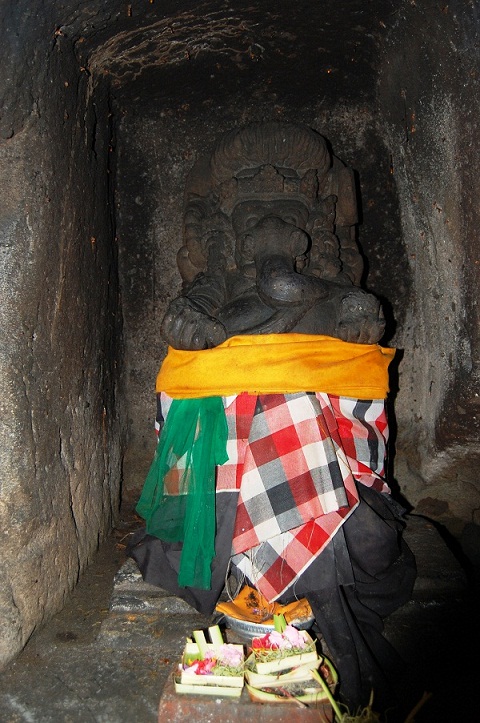
Statue of Lord Ganesha inside
the Goa Gajah caves.

Ratu Trilingga - Three Shiva
Linga
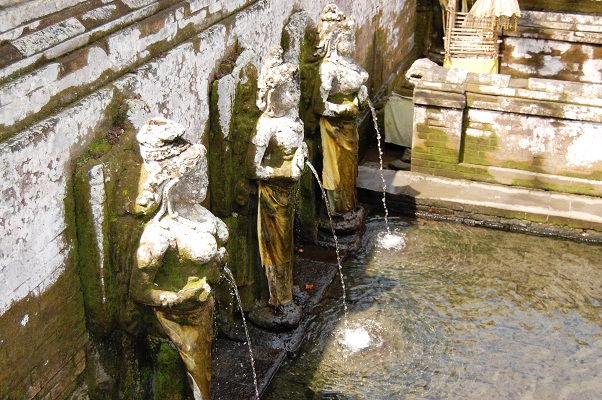
Sacred tirtha water at the Goa
Gajah caves in Ubud, Bali.
(image source:
webmaster's own collection of photos taken during a recent visit).
***
Village
of Yeh Pulu
The carving is between rice field and ravine of Pekerisan river. The site was
rediscovered in 1925 by the archaeologists covered by moth and shrubs yet local
people still knew them and put some offering at the front of the carvings. In
1949 a simple protection was laid out to avoid water flowing on the surface of
the relief. It looks like panel with the size of 25 x 2 meters full with
carvings.

The wall carvings tell the
story of Kresna (Krishna) as a youth.
The relief carving in Yeh Pulu depicts
the daily life of island people its fully chiselled on rock wall
for about 25 meters and some parts depicts Krishna’s
manifestations. Dating 14th Century.

At the end of the wall carvings
is the image of Lord Ganesha with flower offering in the front of it.
***
Other
Hindu temples in Bali, Indonesia
Gunung
Kawi
After Goa Gajah, this
Vishnu
Temple
is said to be the second oldest temple in
Bali
built around 11th century.
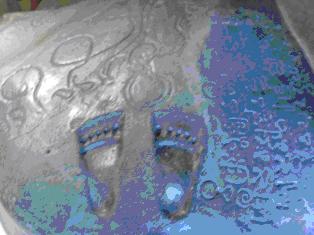
Lord
Vishnu's footsteps in Bali.
(Some
images
and text contributed to this site by
Vikneswaran
Shunmugam,
Indonesia).
***
Much of the place still intact except the entrance part
which in ruins due to earth quake. The rock cut and chiselled
shrines are of rock mountain. There are so many alters but all
the statues are gone, either kept in secret by villagers and
some in
Bali
museum.

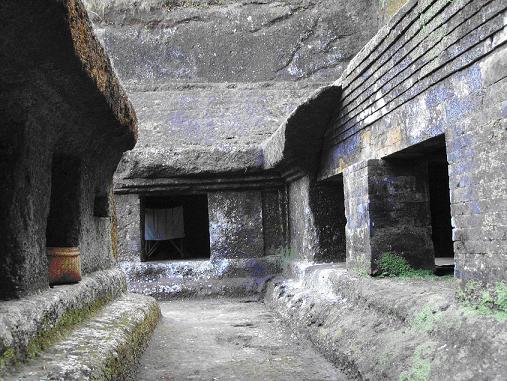
Vishnu
Temple
is said to be the second oldest temple in
Bali
built around 11th century.
(Images
and text contributed to this site by
Vikneswaran
Shunmugam,
Indonesia).
***
Legend
says that temple is built for king Udayana, his Javanese queen
Guna Pria Dharma Patni, his concubine, his oldest son Airlangga
who ruled
East Java
, and his youngest son Anak Wungsu. Anak Wungsu ruled on
Bali
from 1050 to 1077. The four temples on the west side of the
river should then have been built for the chief concubines of
Anak Wungsu.
Tirtha
Empul –
is revered by all Balinese. They
say that it was created by the god Indra when he pierced the
earth to create a spring of amrita, the elixir of immortality,
with which he revived his forces who were poisoned by the evil
king, Mayadnawa. The bathing place was built under the rule of
Sri Candrabhaya Singha Warmadewa in the 10th century.
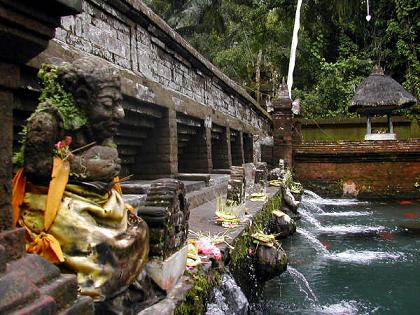 The
waters are believed to have magical curative powers.
Every year people journey from all over Bali to purify
themselves in the clear pools. After leaving a small offering of
thanks to the deity of the spring, men and women go to opposite
sides to bathe. The
waters are believed to have magical curative powers.
Every year people journey from all over Bali to purify
themselves in the clear pools. After leaving a small offering of
thanks to the deity of the spring, men and women go to opposite
sides to bathe.
Pura
Arjuna Metapa –
Temple where Arjuna meditated
is just south of the Pura Pusering
Jagat – Temple of the Navel of the World. Arjuna is
the hero in the epic of Mahabharata. In this story, Arjuna is
meditating on a mountain top, gathering his energies for an
upcoming battle with the evil demon Niwata Kawaca.
Pura
Bukit Dharma –
Found
here is the famous 7 ft high statue of the Goddess
Durga
in the act of killing a bull possessed by a demon under her
feet. In a fighting attitude, her four arms hold a spear, an
arrow, a cakra, a shield, a bow and a winged conch shell.
Goddess Durga is the wrathful aspect of Siva’s wife or Shakti.
Pura
samuan Tiga
– which means the temple “of a meeting of three parties.”
During the reign of Queen Gunapriya
Dharmapatni and King Udayana (988-1011), Balinese
religion had no cohesiveness, no basic tenets which everyone
followed. Therefore six holy men gathered at Pura Samuan Tiga to
try and simplify the existing religion. Out of this meeting
emerged the key tenets of Balinese Hinduism today a) the three
elements of manifestation of Sanghyang Widhi, or the Absolute
God, being Shiva, Brahma and Vishnu 2) the triune temple system
in each village 3) the concept of desa adapt.
Pura
Jagatnatha
– Every full moon, young people pay homage at this
temple. Dedicated to the Supreme God – Sandhyang Widi Wasa.
The tall padmasana, constructed of white coral, symbolizes
universal order. The turtle Bedawangnala and two naga serpents
represent the foundation of the world; the towering throne
signifies the receding heavens. This design, so prevalent on the
island, relates to the Hindu myth of the churning of the ocean
of milk, when the gods and demons stirred the cosmic ocean to
create the nectar of immortality.
The Catuh Mukha, Lord Shiva
in his four faced emanation, overseas traffic in the city of
Denpasar main intersection.
Sangeh
– Ravana, the villainous giant of the Ramayana epic, could die
neither on earth nor in air. To kill him, the monkey general
Hanuman devised a plan to suffocate the giant by pressing him
between two halves of the holy mountain Mahameru – a
destruction between the earth and air. When Hanuman took
Mahameru, part of the mountain fell to the earth in Sangeh,
along with a group of monkeys from his army, whose descendents
stayed to this day.
Such
is the legendary origin of Bukit Sari, or The Monkey Forest, a
cluster of towering trees and home of hundreds of spritely
monkeys. The forest is sacred and for many years no one has been
permitted to chop wood here. A moss covered temple lies in the
heart of the woods. The temple, Pura Bukit Sari, has a large
statue of Garuda in the central courtyard.
Pura
Besakih – Mother Temple called thus, as it houses
ancestral shrines for all Hindu Balinese. A cluster of temples,
Pura Besakih is the pinnacle of the sacred to all Balinese. It
has 86 temples with 22 main temple complexes. It was built in
the 8th century, some of the structures were added later in 14th
to the 18th century. Today it is the state temple for the
provincial and national governments which meet all the expenses.
Within the Besakih complex, the paramount sanctuary is the Pura
Panataran Agung with its lofty merus on a high bank of terraces.
Steps ascend in a long perspective to the austere split gate,
Inside the main courtyard stands the three seated shrine
enthroning the three aspects of God: Shiva, God as creation;
Pramashiva, god without form and Sadashiva, God as half male and
half female. Many interpret this trinity to be Brahma, Vishnu
and Shiva. There are three colors associated with the shrine:
red, black and white. Red symbolizes the earth as lava and is
associated with Shiva, and black is both water and outer space
and associated with Vishnu.
Pura Ulun Danu Bratan – temple is dedicated to the
Goddess of the Lake, Devi Danu, and her consort Vishnu,
who rules over water. This is one of the two main subak temples
in Bali which determine how water reaches the irrigation ditches
all over southern Bali.

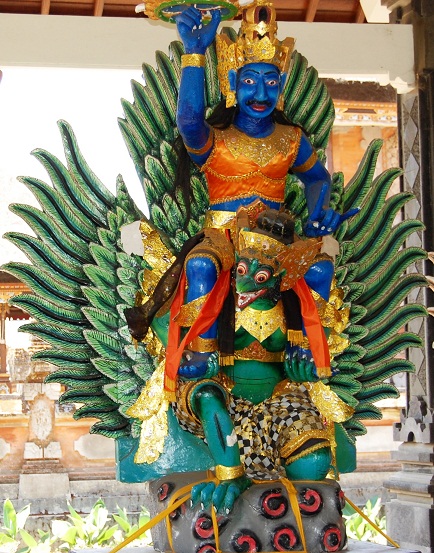
Lord
Ganesha at the entrance to the Pura Ulun Danu temple and Lord Vishnu or his
mount Garuda.
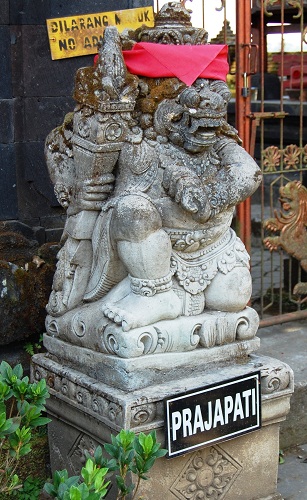
Prajapati
(image source:
webmaster's own collection of photos taken during a recent visit).
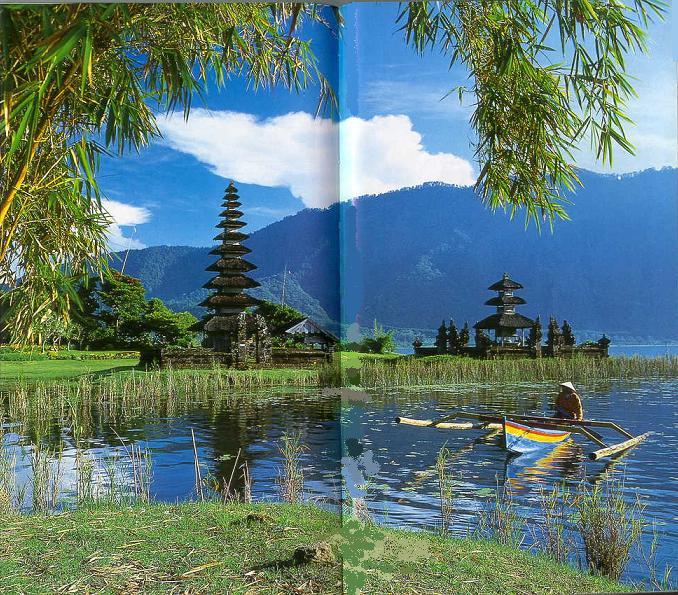
Temple
is dedicated to the Goddess of the Lake, Devi Danu, and her
consort Vishnu, who rules over water.
(image
source: Insight Guides – Bali –
created by Hans Hofer and Eyewitness
Travel Guide to Bali & Lombok0
(For
more refer to chapter on Greater
India: Suvarnabhumi and
Sacred
Angkor).
***
Pura
Ulun Danu Batur - This temple is one of the most important on Bali
because of its association with Lake Batur, which supplies the irrigation system
of Gianyar and Bangli through a series of underground springs. From a distance
the temple' silhouette can be seen on the rim of the vast Batur caldera. Garuda
- is depicted in stone relief on the courtyard wall. Devotees from all
over Bali present elaborate offerings at this temple, which is dedicated to Ida
Betari Dewi Ulun Danu, the goddess of Lake Batur. The respect accorded to the
goddess is reinforced by events in the temples history. At its former location
closer to the lake, the temple was miraculously saved from destruction in the
volcanic eruption of Gunung Batur of 1917,
when the lava flow stopped just short of its walls. Another eruption, in 1926
prompted the villagers to move the temple to its present location.
Gunung Batur is not the
largest volcano in Bali, it is the most active. It is surrounded by a
spectacular caldera, which implies that it was once much larger than now, having
blown off its top in an eruption. It has erupted on a large scale more than 20
times in the last 200 years.

Pura Ulun
Danu Bratan temple - dedicated to the Goddess of the Lake - Devi Danau - a
consort of Lord Vishnu. She who blesses the island with water for irrigating the
rice fields.

Hindu gods
for a festival in the temple.
(image source:
webmaster's own collection of photos taken during a recent visit).
***
These waters, enriched with volcanic
minerals from the Batur highlands, lead from one terrace to
another in descending steps to the sea.
Pura
Saraswati at Ubud
The royal family commissioned
this temple and water garden, dedicated to Goddess Saraswati - the Hindu
goddess of art and learning, at the end of the 19th century.
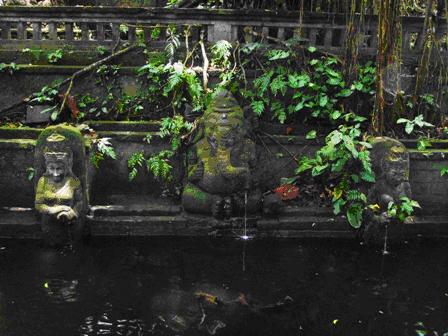

Monkey
Forest
, Ubud,
Bali
.
Sacred
Monkey
Forest
of
Padangtegal during the mid-14th century. It is possible that
this temple was built by the Pejeng Dynasty (the Pejeng Dynasty
was centred on
Bali
in the vicinity of Ubud and was conquered by the Majapahit
empire in A.D. 1343).
(Images
and text contributed to this site by
Vikneswaran
Shunmugam,
Indonesia).
***
(source: Insight Guides – Bali –
created by Hans Hofer and Eyewitness
Travel Guide to Bali & Lombok). Refer to My
Bali Diary - By B Raman - saag.org).
(Note:
Recently an Ancient
statue of Lord Vishnu
has been found in Russian
town of the Volga region.
For more refer
to chapter on Suvarnabhumi).
Pura
Blanjong - Houses the oldest example of writing known as Prasati
Blanjong inscribed on 70 in tall stone pillar. Dating from AD 913 - Sanskrit -
displays Hindu influence in Bali 3 centuries before the arrival of Java's
Majapahit Court.
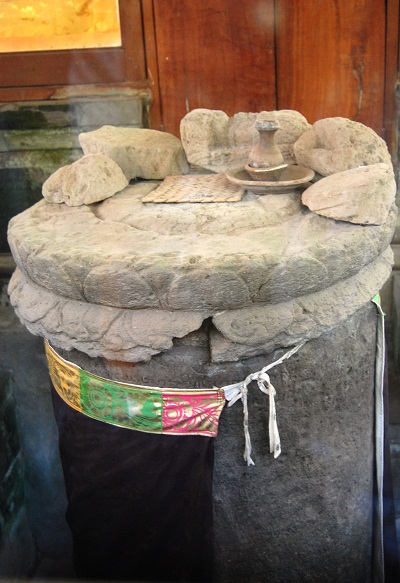
The oldest
Sanskrit inscription on a preserved pillar in the Prasasti Blanjong temple in
Sanur, Bali.
(image source:
webmaster's own collection of photos taken during a recent visit).
***
Pura
Segara - located in Sanur - dedicated to the God of Sea. An unusual
temple made of coral. Has a bright statue of Lord Ganesha.

A bright
blue Ganesha in the Pura Segara temple in Sanur, Bali.
Pura
Pusering Jagat - one of the holiest temples - 1000 year old - is
famous for "churning of the Sea of Milk - elaborately carved cylindrical jar out
of a single sandstone.
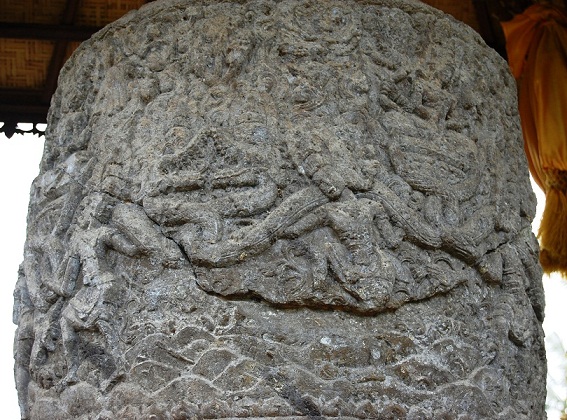
Churning of
the Sea of Milk carved out of a single sandstone.
(image source:
webmaster's own collection of photos taken during a recent visit).
***
Wanar Wana
- Monkey Forest in Ubud
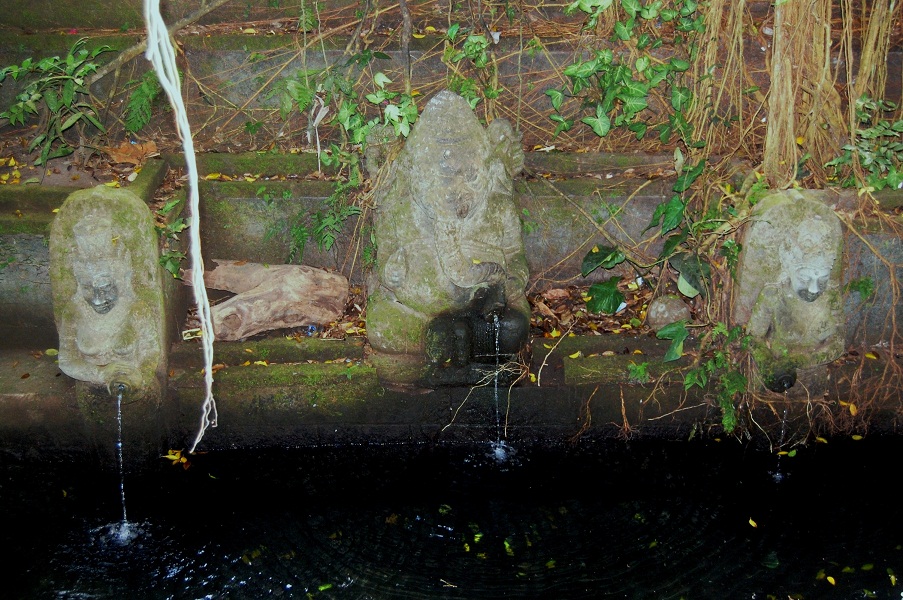
Lord
Ganesha - sacred water falls from his tusk in the Wanar wana (monkey
forest).
One of the
oldest and most haunting places in Bali and is located near a deep gorge and old
baniyan trees.
(image source:
webmaster's own collection of photos taken during a recent visit).

Ganesha statue at Pura
Uluwatu temple, Bali.
(image source:
webmaster's own collection of photos taken during a recent visit).
***
The
Vanishing Gods of Bali
Bali - A new Western Playground
Tourism and Westernization are
taking a toll on authentic Balinese Hinduism 
Note: Foreigners visiting Bali public temples are hounded to give
donations. In spite of paying the entrance fee - Con artists descent on
unsuspecting visitors for more donations in order to visit the inner sanctum of
the famous temples such as Pura Besakih and
Pura Danu Batur in the Northeast and North
respectively.
Gods are for sale ?

Pura
Besakih - Mother Temple of Balinese Hinduism.
Scams
abound around the temples - Numerous people are found loitering around the
temple to exploit tourists. This kind of behavior takes away the spirituality of
visiting the Mother Temple of Hinduism in Bali.
(image source:
webmaster's own collection of photos taken during a recent visit).
Refer to
chapters on
Ethereal Prambanan,
Suvarnabhumi,
Pacific Waves,
Seafaring in
Ancient India.
***
Scams abound around the temples - Numerous people are found loitering
around the temple to exploit tourists. This kind of
behavior takes away the charm and spirituality of visiting the Mother Temple of
Hinduism in Bali.
There are
hardly any Hindu murtis (statues) to be seen even after paying the donations. A
better option would be to visit the
ancient authentic temples in Java
with their beautiful architecture and no one pestering for donations.
Refer to chapter on
Ethereal Prambanan
Tourism is
changing the attitude of the people. Gods are for sale and temples are untidy in
spite of the donations. That translates in loss of charm for Balinese
Hinduism.
***
The island
of a thousand Gods
Construction cranes on beaches, damaged coral, and floating trash in the
turquoise waters off Bali are an unfortunate sign of just how successful the
Indonesian resort island has been in attracting tourists. Foreign visitors have
been drawn to the unique Hindu culture, art and volcanic landscapes of Bali
since the 19th century, but in recent years growing wealth in Asia has spurred
new hordes of tourists from around the region.

A dvarpala deity in a traditional home.
***
The flood of cash from these conferences, during which room prices surge due to
tight demand, is prompting the bulldozing of hills for more resorts in an island
that some people already think is far too crowded, with little or no thought
given to the limits of the environment. "What is happening in Bali now is
over-exploitation of the tourism industry. A policy of selling it cheap, and
exploiting it to the last bit," said Wayan Suardana, the head of local green
group Walhi in Bali. With not enough fertile land to go around, tourism
provided jobs in hotels, services, manufacturing of things such as souvenirs and
furniture, and construction.
Bali Beach
Trash Shows ‘Island of Gods’ Hurt by Tourist Boom
In addition, the hotels produce growing mountains of trash. Some 13,000 cubic
meters of trash arriving at processing plants across Bali per day, but only half
is being processed, said Alit Sastrawan, head of the agency. Lack of monitoring
has also meant that trash from big hotels may be dumped on just any available
empty land, said Made Suarnata, the head of the Wisnu Foundation, which
campaigns for community-based waste recycling.
A predominately Hindu enclave in Muslim-majority
Indonesia, Bali has drawn travelers since German painter Walter Spies
moved there in 1927, becoming a bellwether for economic wealth from U.S. surfers
in the 1960s to Japanese golfers in the 80s. Perhaps even more serious is
damage to one of the island's biggest draws, its pristine waters.
(source:
Tourism takes a toll to Bali unique culture
and
Bali Beach Trash Shows ‘Island of Gods’ Hurt by Tourist Boom).
Modern
Sculptures in Bali 
This new park was started in
mid 1990s and which may never be completed, is supposed to showcase Balinese art
and culture. The focus of the 250 hectare site will be a 66 meter high bronze
statue of Lord Vishnu riding upon Garuda built on a hill. Today only the armless
head and torso of Wisnu sticks out of the ground; on a nearby cliff protrudes
the head of Garuda. The park has rather an artificial atmosphere.
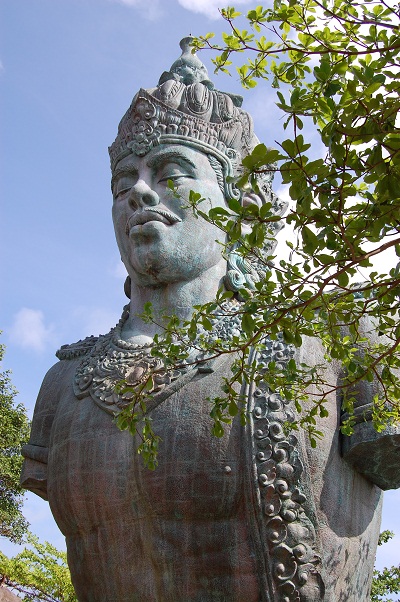
Lord Vishnu
bust in Garuda Wisnu Kencana Cultural Park.
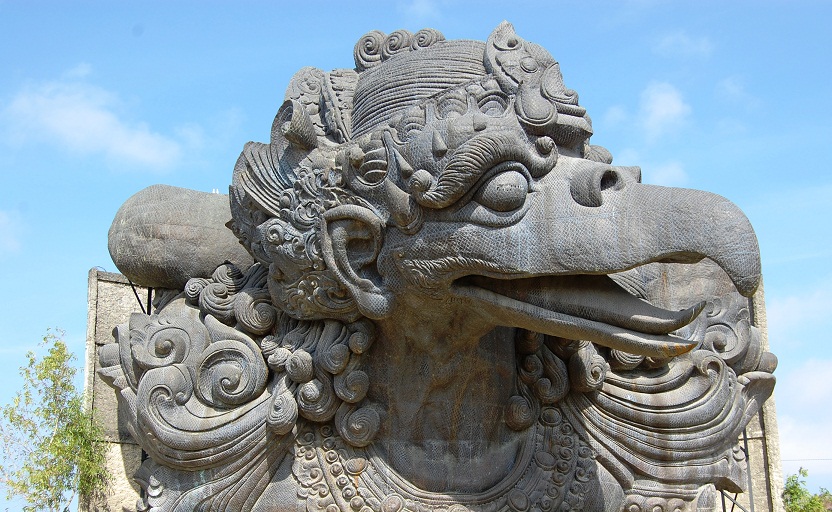
Garuda -
Wisnu (Lord Vishnu) vahana.
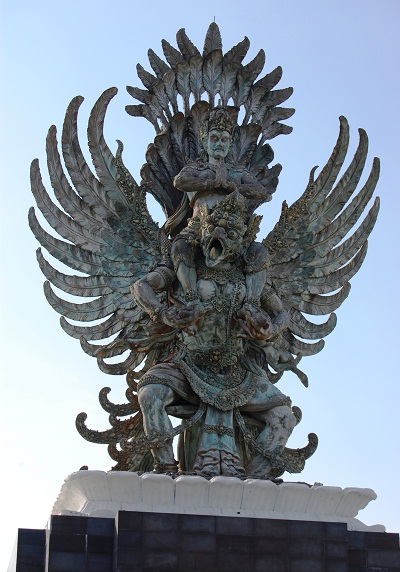
Wisnu on
Garuda in Nusa Dua.
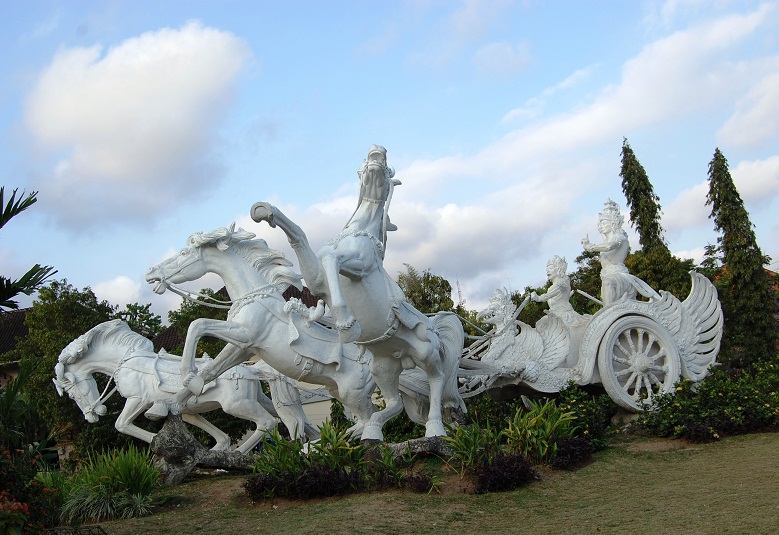
Arjuna and
Kresna (Lord Krishna) sculpture in Gianynar, Bali.
(image source:
webmaster's own collection of photos taken during a recent visit).
***
Top
of Page
US
couple goes the Hindu way in marriage
She's a
Jew from California, he's a Christian from Arizona, but both
chose to get married according to Hindu rituals in Orissa's
temple town of Konark.
Thousands
of people attended the wedding of the American couple, Rabital
Volk, 33, and Cain Carroll, that took place last week at a yoga
ashram in Konark, 70 km from Bhubaneshwar. They had been
formally married in the US earlier, but decided to go in for a
Hindu wedding as well. Every
traditional detail was observed - there were Vedic mantras, a
priest, a fire and even two locals, who stood in for the bride's
parents for the ritual of kanyadan to give her away.
Rabital had
first come to India three years ago as a tourist and toured
several religious spots like Rishikesh and Varanasi before
finding her moorings in Konark. Her husband followed her and
came to teach yoga. Both worked at the Konark Natya Mandap (KNM),
a dance institute founded by famous Odissi guru Gangadhar
Pradhan -- Rabital as a student and Cain as a yoga
teacher.
"
India is the birthplace of yoga and Vedic
traditions and spirituality fascinates me," said Cain.
"This was a marriage with a difference. It hardly matters
that they belong to other religions. Their love for our culture
and tradition motivated me," said Prafulla Mohapatra, the
priest, who conducted the rituals.
(source: US
couple goes the Hindu way in marriage - hindustantimes.com).
For more refer to chapter on Yoga
and Hindu Philosophy.

Sage
Patanjali
The Yogic practices originated in the primordial depths of
India's past. India is the birthplace of
Yoga and Vedic
traditions and spirituality.
***
About
Rishi Patanjali
Snake temples at Prayag
honor the sage Patanjali’s yogic mastery. His
name means “gift of a snake.” It signifies that Patanjali
had mastered the Kundalini,
the serpent-like energy in the subtle body.
Nag
Kuan: The place, where on Nagpanchmi day, the snake worship is
held, is connected with Rishi Patanjali the famous Sanskrit
grammarian, located at Jaitpura (3rd BC). Chidambaram: It was here that Lord Siva performed the Tandava
dance of creation, and where sage Patanjali later lived and
wrote the Yoga Sutras.
(source:
About
Rishi Patanjali - Hinduism
- By Linda Johnsen p. 222. For more refer to chapter on Yoga
and Hindu Philosophy).
Top
of Page
Page < 1 2 3 4 5 6 7 8 9 10 11 12 >
|